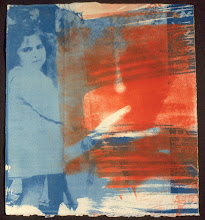The second time I heard El Camino calling me, was in Saintes-Maries-de-la-mere, in Camargue. My husband and I went to the South of France to visit a friend. On a day trip we stopped at the little town of Saintes Maries de la mere, a small place where the french culture mingles with the Spanish, and the Gypsy. We went to visit the main church, Notre Dame de la Mer. A sanctuary that is one of most important departure points for Pelegrins who start from there their Camino to Santiago de Compostela.
We visited the roof of Church, a real accomplishment for me, since I do not like climbing on roofs. My husband suggested I take my shoes off, so I could have better controll and balance. He was right.
When we came down we saw at the church courtyard a very beautiful piece of artwork, a big stain glass installation inspired by the Camino. On its surface it was written: l’amour est fort comme la mort. Love is as strong as Death!
And somewhere near by there were photographs and information about the two thousand year old pilgrimage to Santiago.
After I had conquered my fear of heights I felt drown to the challenge of walking from that very spot to Santiago de Compostela.
I asked my husband to accompany me. He was not that interested.
But I felt inside my heart the call to become a pilgrim. I knew that some day I was going to do what seemed almost impossible. Walk across Spain, walk towards a goal.
(to be continued)
We visited the roof of Church, a real accomplishment for me, since I do not like climbing on roofs. My husband suggested I take my shoes off, so I could have better controll and balance. He was right.
When we came down we saw at the church courtyard a very beautiful piece of artwork, a big stain glass installation inspired by the Camino. On its surface it was written: l’amour est fort comme la mort. Love is as strong as Death!
And somewhere near by there were photographs and information about the two thousand year old pilgrimage to Santiago.
After I had conquered my fear of heights I felt drown to the challenge of walking from that very spot to Santiago de Compostela.
I asked my husband to accompany me. He was not that interested.
But I felt inside my heart the call to become a pilgrim. I knew that some day I was going to do what seemed almost impossible. Walk across Spain, walk towards a goal.
(to be continued)














































